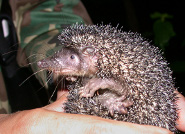 The greater hedgehog tenrec (Setifer setosus), also called the Madagascan hedgehog or Madagascar tenrec, is native to northern and eastern Madagascar. Though they are similar to hedgehogs, the Madagascar tenrec has a larger body and a more rounded snout. Like a hedgehog, their backs and tails are covered in short, sharp spines; while their legs and undersides sport a softer fur. Madagascar tenrecs range in length from 6 inches to just shy of 9 inches (15-22cm) and range in weight from 6.3 to 9.5 ounces (180-270 grams). Their spines are black with white tips, though the fur may be light or dark in color.
The greater hedgehog tenrec (Setifer setosus), also called the Madagascan hedgehog or Madagascar tenrec, is native to northern and eastern Madagascar. Though they are similar to hedgehogs, the Madagascar tenrec has a larger body and a more rounded snout. Like a hedgehog, their backs and tails are covered in short, sharp spines; while their legs and undersides sport a softer fur. Madagascar tenrecs range in length from 6 inches to just shy of 9 inches (15-22cm) and range in weight from 6.3 to 9.5 ounces (180-270 grams). Their spines are black with white tips, though the fur may be light or dark in color.The Madagascan hedgehog can be found primarily in dry forests or agricultural areas, though they may also be found in more humid or subtropical forests and highlands all over Madagascar. Their varied diet consists of fruits, insects, earthworms, reptiles and amphibians, and even carrion. During colder winter months, the Madagascar tenrec will often stick to a smaller foraging area or, if conditions are particularly tough, go into torpor. Torpor, something different than hibernation, is a state of inactivity or suspended activity in which an animal’s bodily functions slow down to conserve energy and let the animal survive bad weather.
The greater hedgehog tenrec is nocturnal and generally a solitary animal.
The Madagascar tenrec is different from other tenrecs in that its defense mechanism is more docile. Rather than using its spines to attack potential enemies, it behaves more like a traditional hedgehog, rolling into a ball with its spines out. This spiny ball offers the tenrec protection from predators, which may include birds of prey, snakes, and carnivorous mammals called viverrids. Though it is unrelated to the hedgehog, the fact that Madagascar tenrec shares this particular trait is why it is called a hedgehog.
On the International Union of Conservation of Nature and Natural Resources (IUCN) list of threatened species, the threat to the greater hedgehog tenrec is low. No foreseeable threats loom that may harm the population of these solitary, spiny creatures, and they are therefore not considered endangered.
In the vast variety of creatures on the island of Madagascar, the greater hedgehog tenrec may seem small. But this little animal differs both from hedgehogs and other tenrecs, giving it a unique personality in the world of mammals.
Picture of the greater hedgehog tenrec by Tom Junek, licensed under the Creative Commons Attribution-Share Alike 3.0 Unported license.
The Greater hedgehog tenrec, large madagascar hedgehog is listed as Least Concern. Does not qualify for a more at risk category. Widespread and abundant taxa are included in this category, on the IUCN Red List of Threatened Species
Countries
MadagascarGreater hedgehog tenrec or Madagascan hedgehog habitats
Artificial / Terrestrial, Dry savanna, Forest, Grassland, Moist savanna, Rural Gardens, Savanna, Shrubland, Subtropical / Tropical Dry forest, Subtropical / Tropical Dry Grassland, Subtropical / Tropical Dry Shrubland, Subtropical / Tropical High Altitude Grassland, Subtropical / Tropical High Altitude Shrubland, Subtropical / Tropical Moist Lowland, Subtropical / Tropical Moist Montane, Subtropical / Tropical Moist Shrubland and Urban AreasSome facts about the
Greater hedgehog tenrec
Adult weight : 0.225 kg (0.495 lbs)
Maximum longevity : 14 years
Female maturity :198 days
Male maturity : 258 days
Gestation : 54 days
Weaning : 24 days
Litter size : 3
Litters per year : 1
Weight at birth : 0.025 kg (0.055 lbs)
Basal metabolic rate : 1 W
Body mass : 0.428 kg (0.9416 lbs)
Temperature : 31.85 °C (89.33 °F)

Custom Search